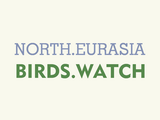search
classification
|
basic information
|
video
|
reports |
Caspian Tern
Hydroprogne caspia (Pallas, 1770)

|

|
|
|
2020-06-06
island Spasskiy, Ulan-Ude |
© Grigory Khasanov
|
|
Description
The Caspian Tern is the largest tern of Eurasia. Its weight is 6-7 time more than one of the Common Tern, and in comparison to gulls the Caspian tern is larger than Black-headed and Common gulls, and only a bit less than members of the “big white-headed gulls” group. Adults in spring plumage have black upper head and hindneck, elongated feathers of nape form a little tuft Back is bluish-grey, rump and rectrices are lighter, almost white. Bill is large, red, the head and the bill look massive. Legs black with orange foot bottoms. Iris dark brown. In winter plumage, birds have white head with black streaks along it and on head flanks. Young birds have white head with brown streaks and spots. Back feathers grey with ochre margins and brownish arrow-form streaks. Tail feathers have brown subterminal spots and ochre tips. Bill orange, legs black. Sizes (mm): wing 380-400, tarsus 40-47, bill 60-75. Weight: 500-700 gr.
Distribution
The Caspian tern is distributed on all continents but Antarctic and South America, its breeding locations are local and often are situated for hundreds and even thousands kilometers from each others. Sometimes it breeds on lakes of steppe and forest-steppe zones in the south of Siberia. From 1970s it regularly breeds n the Selenga river delta on Lake Baikal; colonies on the Torey Lakes have disappeared in the early XXI century because of the dry period. As a vagrant and a migrant, it is recorded on many water pools, mainly in the arid zone.
Biology
In Siberia, the Caspian tern inhabits large lakes being rich in fish. In spring, it appears in early May. Nests in dense colonies, usually on low sandy islands with sparse vegetation or without it. Some colonies are of several hundreds of birds. The nest is a small hole (4-7 cm in depth) without any bed or with few pieces of dry grass. Nests are situated in 0.6-4 m from each other. The clutch –f 1-3 eggs (most often 3) is laid in late May or early June. Both parents incubate (20-22 days) and then feed chicks. Young birds begin to fly being something more than a month old. Caspian terns actively their colonies, with loud calls attacking anyone coming to their nests. Even crows and large gulls couldn’t get close to their colony. The main food is a fish, rarely – large water invertebrates. After fledging of juveniles, Caspian terns are nomadic, usually doing not form large flocks of more than 5- individuals. Their movements are wide, birds can appear in any direction from their breeding locations, even very far to the north. The majority of birds leave breeding areas in mid-August, a few ones can be seen to mid-September.
References
"Птицы Казахстана", том 2. Алма-Ата, 1962.
"Птицы дельты Селенги" / И.В.Фефелов и др. Иркутск, 2001.
В.К.Рябицев. "Птицы Сибири". Москва-Екатеринбург, 2014.













